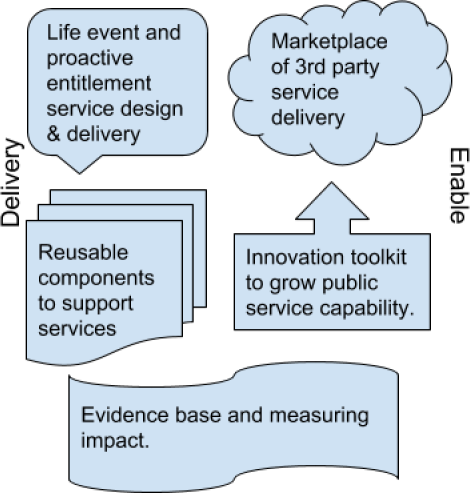TL;DR
People are often curious about what we are doing and why. There’s a lot of interest from a range of organisations and individuals in our work, so I’d like to share a bit about the Service Integration (LabPlus) approach and how we work.
Below are some of the key challenges facing government in creating sustainable, relevant and responsive services, including the ability of governments everywhere to scale to the increasing complexity of the communities we serve. Then how our Service Integration Work Programme (LabPlus) specifically attempts to addresses these challenges to build better access to public services, through five strategies:
- An independent user centred approach to service design and delivery, and exploration of the future of government services
- A focus on reusable components that can enable greater service delivery more broadly
- Supporting 3rd parties to build on the back of digital government
- A robust services evidence base
- A service innovation toolkit to provide tools to enable the entire public service in their digital service delivery.
The challenges facing government
There are two major service delivery challenges facing governments today which are directly related. The first is around how to design and build genuinely user centred services that are responsive to changing needs over time. The second is how to scale our efforts to the increasing complexity of the system we work within.
Challenge 1: Building adaptive and genuinely user centred services
- Governments around the world have adopted user centred service design methodologies to design and build better services that meet the needs of users. It has been a fantastic race to the top in some jurisdictions, with service designers and user researchers being engaged en masse, and a substantial shift in the thinking around service delivery. Nonetheless despite the enthusiasm there are barriers and challenges in this space including that user research is often done through the lens of a specific agency, agenda or product lens missing opportunities or skewing results.
- There is an incentive to prove an idea rather than genuinely test an idea which can result in suboptimal outcomes.
- When user research identifies the pain points of users, it is tempting to simply choose the largest pain point and solve it which can lead to reinventing legacy processes or systems with new technologies.
- The lack of sharing user research across government means agencies are not building on the back of commonly shared intelligence or insights, and this also means a lack of systemic peer review which would assist in identifying where user research is too narrow in scope.
Challenge 2: Growing complexity and needs gap for society
The complexity of people’s lives is growing. People have local, national and international interests, obligations, rules and activities. They use private, non-profit and public sector services, and relationships that span every possible permutation. It’s increasingly difficult for the public sector to deliver relevant services around user needs within such a rapid pace of change; which is creating a growing gap between user needs and the capacity to respond. Governments need a substantial operational shift to meet these changing needs and the growing complexity of the lives of the people it serves.
How the LabPlus team is responding to these challenges
Service Integration (LabPlus) is responding to these challenges through our all of Government work programme focussed on delivery and enabling others to deliver in a rapidly changing environment.
Delivery
- We have found that a neutral environment with cross disciplinary and cross agency/sector teams following an independent user centred approach can help focus, so we work with agencies, non-profit and private sector partners to collaboratively design, prototype and build new life event and proactive entitlement services in this way.
- In the process of helping design and build new services, we identify potential reusable components of functions that could service more services. Current examples include a government services register and API (Application Programmable Interface) enabled entitlement business rules, which would be used by several “life event services” as well as 3rd parties.
- Knowing that a change has made any difference, let alone the intended difference is a critical part to iterating services to meet user needs. Often user research is used as this evidence, but is insufficient for understanding the user journey across services, across agencies, and across channels. As such we are exploring the notion of a service analytics evidence base to bring together the deidentified service data, to provide a baseline; measure and monitor impact of new service; measure 3rd party adoption; and potentially to prioritise investment we will also measure the value generated for users, government and economy from all of our work.
- Because the Service Innovation team actively works to explore emerging technologies and the future role of government in society, it gives us a chance to identify and work towards a future vision rather than simply iterating away from current pain points.
Enable
- An important need for improving service delivery across government is access to consistent guidance, tools and support services. As such, the Service Innovation Toolkit will be extended to include more functionality to meet the user needs, such as mechanisms for peer review, for code development, sharing resources and more.
- Finally, we will work with 3rd parties that are naturally motivated to deliver services on the back of government information, business rules or transactions to explore the appetite and reality of non-government entities to build on top of government provided functionality (data, content, transactional services and business rules). This model is referred to as Government as a Platform and we will identify, test and document examples as we go.

This diagram is a simple overview of the 5 categories of work above, namely life event and proactive service delivery & design, reusable components to support services, evidence base and measuring impact, innovation toolkit to grow public service capability, marketplace of 3rd party service delivery.


